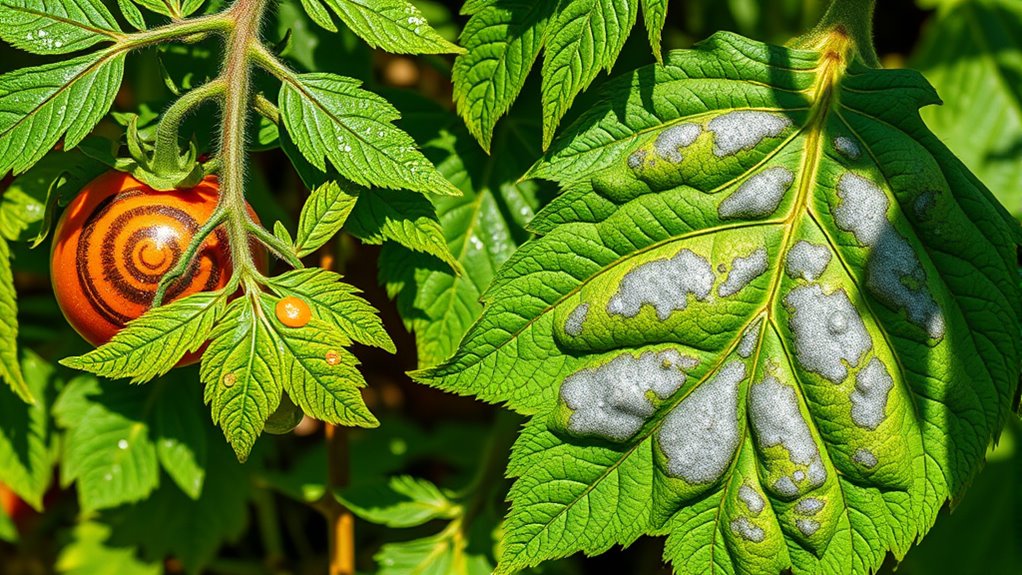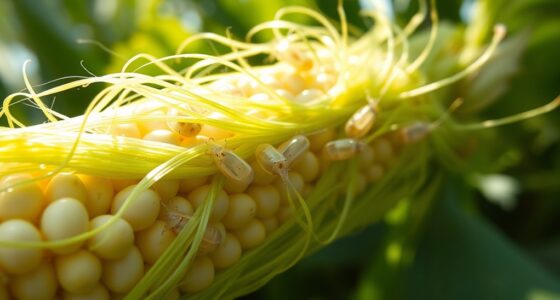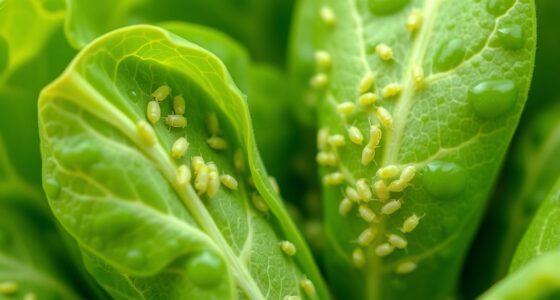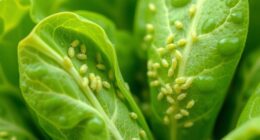To tell early blight from late blight on tomatoes, look for differences in spots and timing. Early blight shows small, concentric rings with yellow halos on older leaves, usually appearing weeks after transplanting. Late blight causes water-soaked, greasy, grayish spots, often during warm, humid weather, and spreads quickly. Spot patterns, lesion textures, and affected plant parts help differentiate them. Keep exploring to learn how to identify and manage these common tomato diseases effectively.
Key Takeaways
- Early blight causes small, concentric-ring spots mainly on older leaves, while late blight produces large, greasy, water-soaked lesions rapidly spreading.
- Early blight lesions are sunken and leathery with yellow halos; late blight lesions are velvety, grayish moldy, and soft.
- Early blight typically appears weeks after transplanting; late blight emerges mid to late season under moist, warm conditions.
- Fruit affected by early blight shows small brown spots with yellow halos; late blight causes large, sunken, greasy spots leading to rot.
- Environmental factors like humidity and rain favor late blight spread, while overcrowding and leaf wetness promote early blight development.
Recognizing the Visual Signs on Tomato Leaves

Tomato leaves often show the first signs of blight through noticeable changes in color and texture. You’ll observe leaf discoloration, where healthy green turns to yellow or brown patches, signaling trouble. These spots may start small but can quickly spread, causing the leaf to wilt or die. Another clear sign is fruit deformation, as the disease progresses, affecting nearby fruits’ shape and growth. You might see uneven ripening, misshapen tomatoes, or puckered surfaces. These visual cues help you catch the problem early. Keep a close eye on your plants, especially during humid weather. Recognizing these early signs allows you to take prompt action, preventing the disease from spreading further and protecting your crop’s health. Regular monitoring can also help identify other issues like plant health deterioration, which may require specific treatments.
The Timing of Disease Appearance During the Growing Season
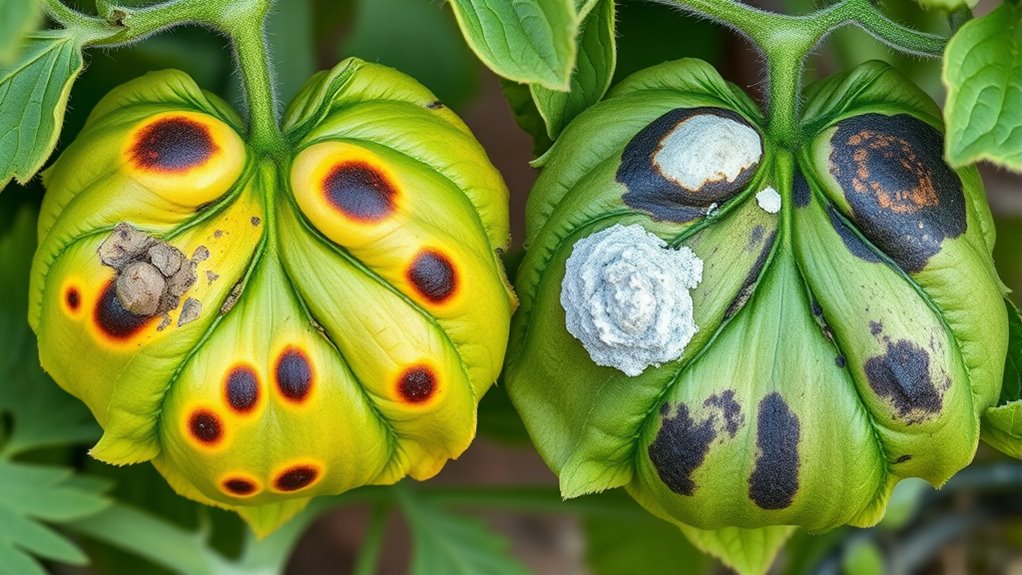
You’ll notice blight can appear at different times during your tomato’s growth, with early and late stages each showing unique signs. Recognizing when the disease shows up helps you take timely action and prevent severe damage. Seasonal patterns also influence when blight is most likely to strike, so understanding these trends is key. Awareness of best practices for disease prevention can further aid in managing outbreaks effectively.
Early and Late Stages
When does blight typically appear during the growing season? Blight can strike early or late, depending on factors like soil health and pest interactions. Early blight often shows up during the initial weeks after transplanting, especially if soil nutrients are imbalanced or compromised. Poor soil health can weaken plants, making them more vulnerable to infection. Late blight usually appears mid to late season, often triggered by prolonged wet conditions and increased pest activity that spread spores. Pest interactions, such as aphids or beetles, can carry fungal spores from infected debris or neighboring plants, accelerating disease development. Recognizing whether blight appears early or late helps you understand its progression and informs timely management strategies to protect your tomatoes throughout the season. Additionally, soil health management plays a crucial role in preventing early blight by promoting strong, resilient plants capable of resisting infections.
Seasonal Disease Patterns
Blight tends to appear at specific times during the growing season, influenced by environmental conditions and plant health. You’ll notice that disease outbreaks often align with periods of high humidity, warm temperatures, or prolonged rain. To minimize risks, focus on improving plant resistance through healthy practices and selecting resistant varieties. Implementing crop rotation is essential, as it interrupts the pathogen’s life cycle, reducing the chance of recurring infections. Sound design techniques like layering sounds can also be used metaphorically to understand how multiple environmental factors combine to influence disease development. 1. You might see blight emerge early in the season when plants are stressed or weakened. 2. Late-season outbreaks can be triggered by persistent moisture and warm weather. 3. Proper management—like crop rotation—can help delay or prevent disease development, keeping your tomatoes healthy and productive.
Distinguishing the Pattern and Location of Spots
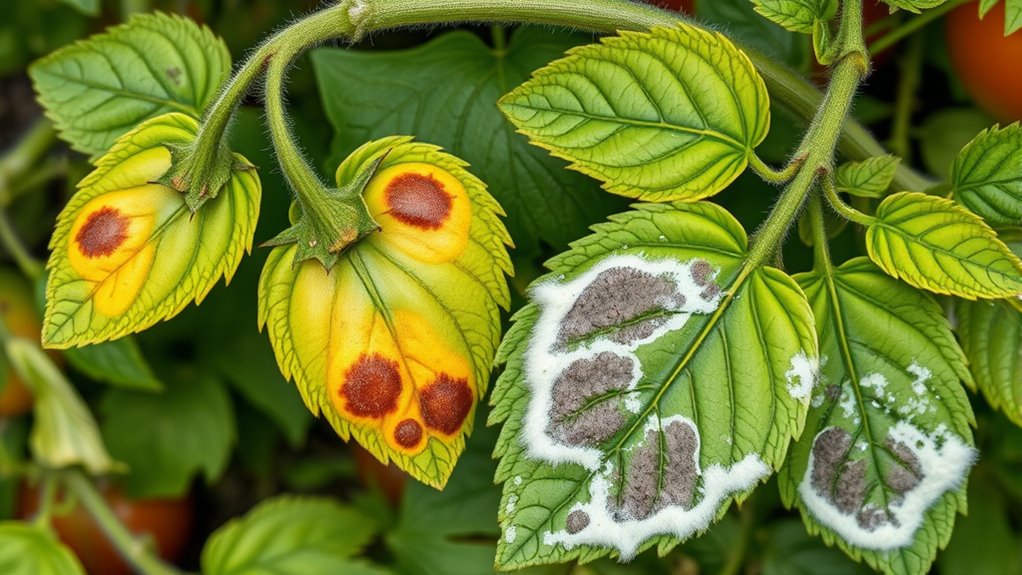
Recognizing blight on tomatoes involves paying close attention to the pattern and location of spots on the fruit. Early blight typically causes concentric rings on older leaves and leaf discoloration, while late blight often shows irregular, water-soaked spots starting at the stem, leading to stem lesions. On the fruit, early blight spots are small, brown, and often surrounded by a yellow halo, mainly on older parts. Late blight causes larger, sunken, and greasy-looking spots that rapidly expand. The pattern helps you distinguish between them. Use this table for quick reference:
| Pattern | Location |
|---|---|
| Concentric rings | Older leaves, leaf discoloration |
| Irregular, water-soaked spots | Near stem, stem lesions |
| Small, brown spots | On fruit, early blight |
| Large, greasy spots | On fruit, late blight |
Additionally, understanding the timing of disease development can help in early identification and management.
Differences in Color and Texture of Lesions

You’ll notice that lesions vary in color, from yellowish to dark brown, indicating different stages of infection. The texture also changes, becoming rough or sunken as the spots develop and spread. Paying attention to these differences helps you identify how the blight is progressing on your tomatoes. Additionally, recognizing the distinctive features of each blight type can assist in implementing appropriate control measures.
Lesion Color Variations
Lesion color and texture can vary widely in tomato blight, providing important clues for identification. Recognizing these differences helps you determine whether you’re dealing with early blight or late blight. 1. Bright yellow or tan lesions often indicate early blight, especially when combined with concentric rings and textured surfaces. 2. Dark, olive-green to black lesions suggest late blight, which can spread rapidly on infected tissues. 3. The impact of genetic resistance and soil health is vital—resistant varieties may show milder lesion colors, while poor soil conditions can exacerbate severe discoloration. Understanding the home furnishings environment can also play a role in managing disease spread and supporting plant health.
Texture Changes Observed
Texture changes in tomato lesions provide critical clues for identifying blight types. Early blight typically causes lesions with a rough, sunken texture, often appearing as concentric rings with slightly raised edges. In contrast, late blight lesions are usually smooth, greasy, and water-soaked, with a soft, leathery feel. These foliar symptoms reflect the underlying pathogen activity and help distinguish between the two. You’ll notice that early blight lesions remain confined to older leaves, while late blight can rapidly spread across the plant. Crop rotation plays an essential role in managing both diseases by reducing pathogen buildup in the soil, which influences lesion development and texture. Paying close attention to these texture changes can help you accurately identify and respond promptly to tomato blights. Monitoring environmental conditions, such as humidity and temperature, is also crucial, as they directly impact disease development and lesion characteristics.
Progression of Spots
As blight progresses, the spots on tomato leaves and stems change noticeably in both color and texture, providing important clues for diagnosis. Early on, you might see dark, water-soaked lesions that feel soft and greasy. As the disease advances, spots darken to brown or black, with a rough, sunken texture. Recognizing these changes helps you differentiate blight types. Hashtags and trends often emerge from viral challenges and memes, reflecting the platform’s influence on popular culture and marketing strategies. Late blight spots often have a velvety, grayish mold on the surface, indicating aggressive progression. Early blight lesions develop concentric rings, with color shifting from yellowish to brown, and become sunken and leathery over time. Using soil amendments and selecting genetically resistant varieties can slow progression, giving you a better chance to manage the disease effectively.
Impact on Tomato Fruit and Stem Symptoms

Blight can considerably affect both the fruit and stems of your tomato plants, leading to visible damage that hampers development and yield. You may notice dark, sunken spots on ripe or ripening fruit, causing it to rot prematurely. Stems can show lesions, cracking, or dieback, weakening the plant’s structure. Poor soil health and lack of crop rotation allow the disease to persist and spread quickly, worsening symptoms. When soil isn’t managed properly, the fungi can survive between seasons, making infections more severe. This results in fruit deformities, reduced harvests, and compromised plant stability. To minimize these impacts, practice crop rotation and improve soil health, which can disrupt the disease cycle and strengthen your plants’ defenses against blight. Additionally, understanding how AI security measures can help monitor and prevent plant diseases is becoming increasingly important for sustainable agriculture.
Causes and Conditions Favoring Each Disease

Understanding the specific causes and environmental conditions that favor each blight disease is essential for effective management. Early and late blights thrive under different conditions, so recognizing these factors helps you prevent outbreaks.
- High soil moisture creates the perfect environment for late blight to spread rapidly, especially during wet weather.
- Poor crop rotation introduces pathogen inoculum into your soil, increasing vulnerability over successive seasons.
- Overcrowded planting and excessive humidity promote leaf wetness, encouraging early blight development.
Preventative Measures and Cultural Controls
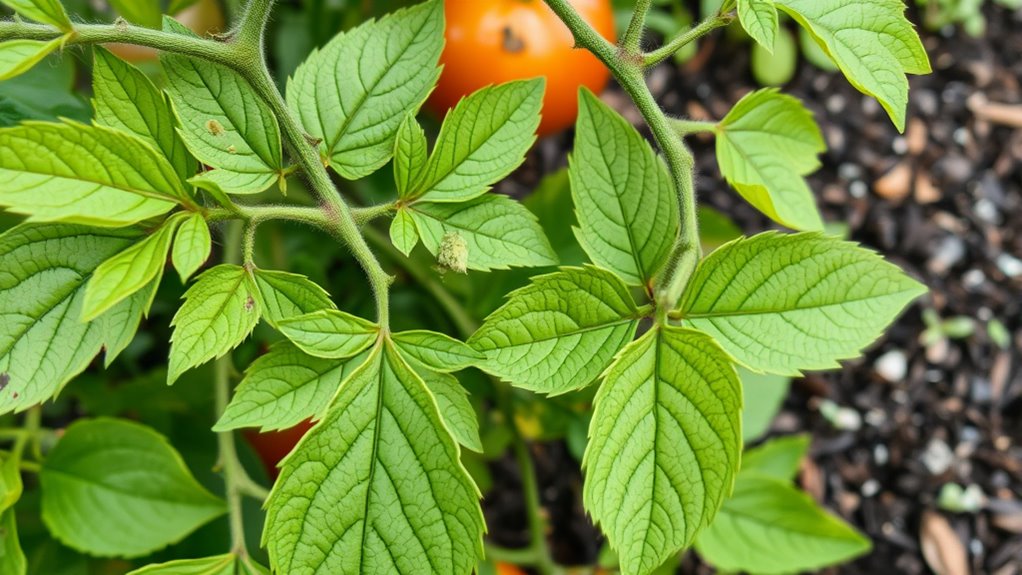
Implementing effective preventative measures and cultural controls is crucial for reducing the risk of blight on your tomato plants. Proper soil management is key; avoid planting tomatoes in the same spot each year. Instead, practice crop rotation by changing locations annually to disrupt disease cycles. Additionally, assure good air circulation by spacing plants appropriately and pruning regularly. Remove and destroy infected debris to prevent spores from overwintering. Keep weeds under control, as they can harbor pathogens. Use mulch to minimize soil splashing onto leaves. Here’s a quick overview:
| Practice | Benefit | Tips |
|---|---|---|
| Soil management | Reduces pathogen buildup | Rotate crops yearly to break disease cycles |
| Proper spacing | Improves airflow | Space plants to prevent humidity buildup |
| Debris removal | Limits spore survival | Remove infected plant material promptly |
Effective Treatment and Management Strategies

When you notice signs of blight on your tomato plants despite preventative efforts, prompt and effective treatment becomes essential to protect your harvest. To combat blight, consider these strategies:
- Use tomato varieties with genetic resistance to reduce vulnerability.
- Practice crop rotation to break the disease cycle and prevent soil-borne spores from thriving.
- Apply fungicides labeled for blight control, following instructions carefully to minimize resistance development.
These approaches, combined with vigilant monitoring, help you manage the disease effectively. Emphasizing genetic resistance and crop rotation gives you a stronger defense against blight, saving your plants and ensuring a fruitful harvest. Remember, early action is key to preventing irreversible damage and maintaining healthy tomato plants throughout the season.
The Role of Weather and Climate in Disease Development

Weather and climate play a crucial role in how quickly and severely blight develops on your tomato plants. Warm, humid conditions promote the spread of both early and late blight, making outbreaks more likely. Climate change is increasing the frequency of these ideal conditions, leading to more unpredictable disease patterns. By paying attention to weather forecasting, you can anticipate high-risk periods and take preventative measures. For example, prolonged rain and high humidity create the perfect environment for fungal growth. Understanding how local weather influences disease development helps you time treatments and cultural practices more effectively. Staying alert to changing weather patterns allows you to protect your tomato crop better and reduce the impact of blight on your harvest.
How to Monitor and Diagnose Tomato Blights Accurately

To effectively monitor and diagnose tomato blights, you need to regularly inspect your plants for early signs of infection. Look for spots, discoloration, or wilting, which can signal the onset of disease. Keep in mind that genetic resistance can help reduce vulnerability, so choosing resistant varieties is essential. Maintaining healthy soil through proper soil health practices strengthens plant defenses, making diagnosis easier.
Pay close attention to these key actions:
- Inspect plants daily for unusual spots or lesions, especially on lower leaves.
- Observe for rapid changes in plant vigor or leaf drop, indicating early blight or late blight.
- Monitor environmental conditions that favor disease development, adjusting watering and airflow accordingly.
Early detection is your best weapon against severe damage.
Frequently Asked Questions
Can Early Blight or Late Blight Occur Simultaneously?
Yes, early blight and late blight can occur simultaneously, especially when environmental conditions like high humidity and poor airflow favor both pathogens. Blight symptom differentiation becomes tricky, but early blight usually shows concentric rings on older leaves, while late blight causes rapid, widespread wilting. You should monitor your plants closely, as environmental influences on blight can accelerate both types, making management more challenging.
Are Certain Tomato Varieties More Resistant to Either Blight?
Some tomato varieties are more resistant to blight thanks to their genetics. You should look for varieties bred through disease resistance breeding, which focus on enhancing tomato plant genetics to fight off early and late blight. By choosing resistant cultivars, you reduce your risk of infection and improve your crop’s health. Always check the labels or consult local growers to find the best blight-resistant tomato varieties for your garden.
How Do These Blights Affect Tomato Yield and Quality?
Blights considerably affect your tomato yield and quality by causing leaf spots, fruit rot, and plant decline. Effective tomato disease management involves early detection and implementing blight prevention strategies like crop rotation, proper watering, and removing infected debris. These actions help minimize disease spread, protect your harvest, and guarantee healthier, better-quality tomatoes. Staying vigilant and practicing good garden hygiene are key to reducing the impact of blights on your crops.
Is Organic Treatment Effective Against Both Types of Blight?
Think of fighting blights like a strategic game—you need the right moves. Organic treatments, including organic fungicides and crop rotation, can be effective against both early and late blight if you stay vigilant. While they may not always be as quick as chemical options, they help build resilience in your plants naturally. Consistent application and good garden practices are key to protecting your tomatoes and keeping your harvest healthy.
What Are the Long-Term Impacts of Untreated Blight Infections?
If you ignore blight infections, they can cause long-term damage to your tomato plants, reducing yield and weakening your crop’s overall health. To prevent this, you should use blight resistant varieties and practice crop rotation to break the disease cycle. Failing to act can lead to persistent infections, making future seasons more challenging and potentially costing you a significant harvest loss over time.
Conclusion
By understanding the subtle dance between early and late blight, you become the vigilant gardener, reading nature’s signals like a seasoned detective. Recognize those telltale spots and patterns before they spread their dark shadow, turning your tomato patch into a fortress of health. With keen eyes and proactive measures, you can outsmart these sneaky foes, ensuring your tomatoes ripen in sunshine, not sorrow—transforming your garden into a lush, resilient paradise.
